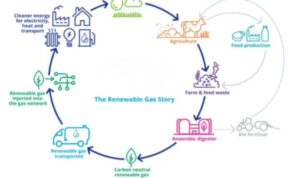A Gas Networks Ireland webinar on biomethane has heard that Ireland has the highest potential for biomethane production per capita in the European Union.
Over 270 farmers, developers, industry bodies and others heard how agriculturally produced biomethane can be delivered sustainably and at scale to decarbonise Ireland’s energy system.
Speakers at the event discussed the process for producing and injecting biomethane into the national network, the proposed Mitchelstown Central Grid Injection facility, and how certification is attained.
A carbon-neutral renewable gas made from farm and food waste through anaerobic digestion, biomethane has already begun to replace natural gas in the national network.
Gas Networks Ireland introduced domestically produced biomethane into the national network in 2019, via the country’s first dedicated renewable gas injection point in Cush, Co Kildare.
A second renewable gas injection facility in Mitchelstown was approved by Cork County Council and An Bord Pleanála in 2020. Together they have the capacity to heat 75,000 homes, while also helping decarbonise local agriculture.
According to GNI, replacing natural gas with renewable gases such as biomethane and hydrogen can deliver a net-zero carbon gas network to complement intermittent renewable electricity generation, meet climate action targets and support a cleaner energy future — while ensuring a secure energy supply.
Business development manager Ian Kilgallon stated: “In the UK, Italy, France and Germany, biomethane is playing an important role in decarbonising sectors such as heat and transport.
“Within both the EU’s Farm to Fork Strategy and Irish agri-food industry, the development of biomethane and the production of a nutrient rich bio-fertiliser digestate, which is a by-product of anaerobic digestion, is seen as a key element in decarbonising agriculture.”
GNI has established a Renewable Gas Registry that records the volume of biomethane injected into the network each month and issues certificates to producers.
The registry facilitates producers in monetising the renewable value of their gas and enables tracking of the renewable value of biomethane in the network, guaranteeing that the equivalent amount of renewable gas has been injected into the network.









